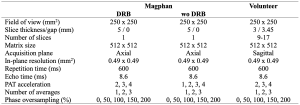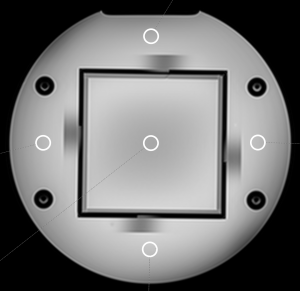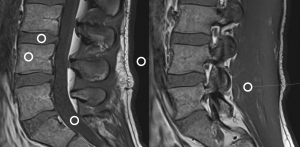When MRI sequences are accelerated, the parallel imaging acceleration (PAT) factor, phase oversampling (PO) and the number of averages (AVE) are often modified. In this study, the impact of changing these parameters on quantitative and subjective image quality was assessed. A cylindrical Magphan MRI phantom (SMR 170, Phantom Laboratory, Greenwich, NY, USA) and a volunteer were scanned with a 3T scanner using both conventional and DRB sequences. A spine coil and a body matrix coil were used. A T1-weighted turbo spin echo sequence was used as a base sequence for both phantom and volunteer acquisitions. In total of 45 images of the phantom were reconstructed with DRB and 60 without it. In addition to phantom images, 25 images of volunteer with DRB were acquired.

Four regions of interest (ROI) were placed to the edges and one ROI in the middle of the phantom in uniformity test plane. Each ROI had an area of 0.71 cm2. In volunteer images, ROIs (area 0.50 cm2) were placed to the vertebral body, intervertebral disc, dural sac, muscle tissue, and background air. The values of signal and noise were collected from the ROIs and SNR was calculated from these values.


Signal intensity and SNR were used as measures of quantitative image quality. Multivariate regression was used to analyse the effect of sequence parameters on signal and SNR. A p-value of 0.05 or lower was considered as statistically significant. Subjective image quality was evaluated by observing the presence or absence of g-factor noise and Gibbs ringing artifacts, and subjective evaluation of the background noise.